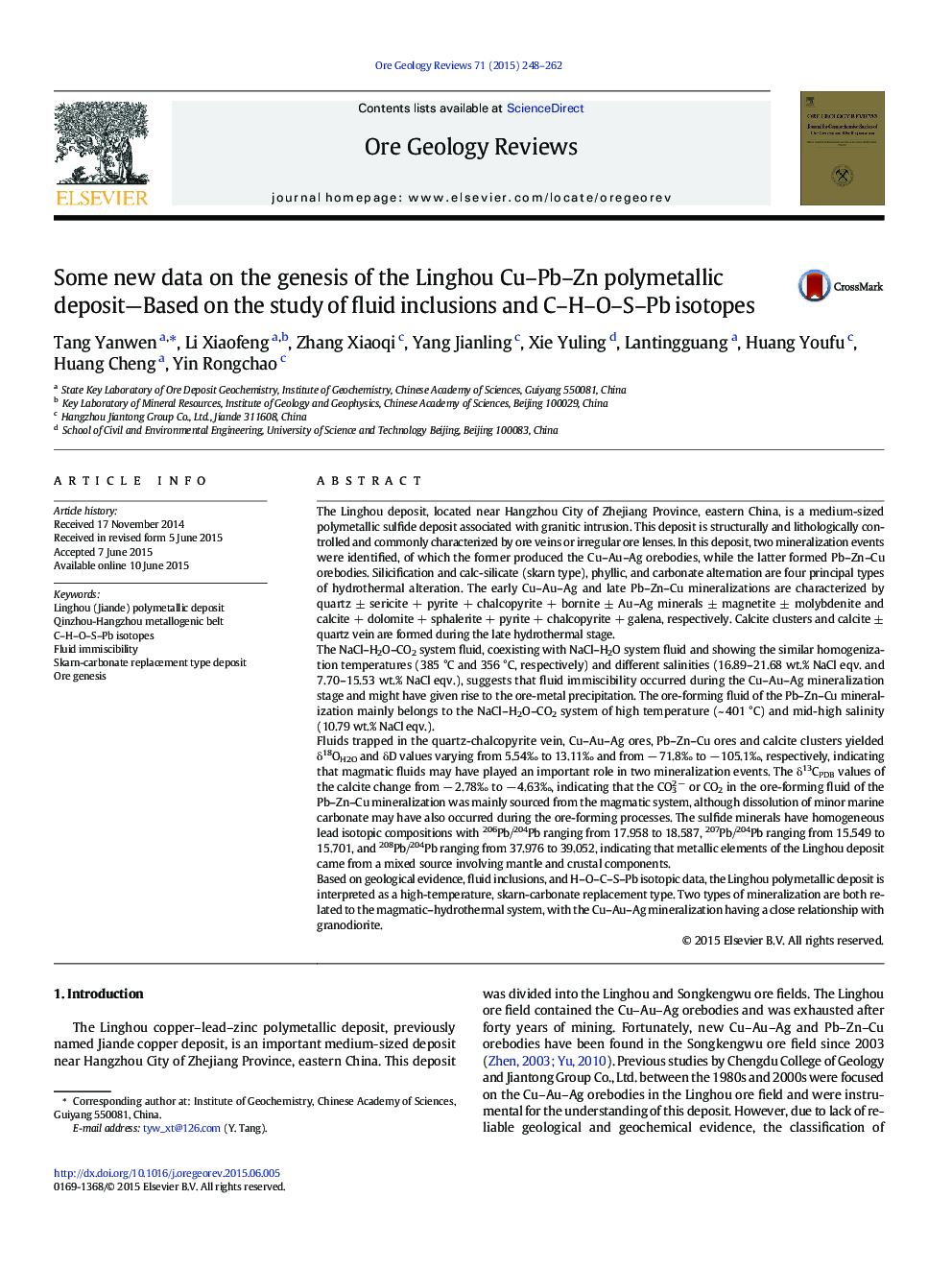| کد مقاله | کد نشریه | سال انتشار | مقاله انگلیسی | نسخه تمام متن |
|---|---|---|---|---|
| 4697019 | 1637233 | 2015 | 15 صفحه PDF | دانلود رایگان |

The Linghou deposit, located near Hangzhou City of Zhejiang Province, eastern China, is a medium-sized polymetallic sulfide deposit associated with granitic intrusion. This deposit is structurally and lithologically controlled and commonly characterized by ore veins or irregular ore lenses. In this deposit, two mineralization events were identified, of which the former produced the Cu–Au–Ag orebodies, while the latter formed Pb–Zn–Cu orebodies. Silicification and calc-silicate (skarn type), phyllic, and carbonate alternation are four principal types of hydrothermal alteration. The early Cu–Au–Ag and late Pb–Zn–Cu mineralizations are characterized by quartz ± sericite + pyrite + chalcopyrite + bornite ± Au–Ag minerals ± magnetite ± molybdenite and calcite + dolomite + sphalerite + pyrite + chalcopyrite + galena, respectively. Calcite clusters and calcite ± quartz vein are formed during the late hydrothermal stage.The NaCl–H2O–CO2 system fluid, coexisting with NaCl–H2O system fluid and showing the similar homogenization temperatures (385 °C and 356 °C, respectively) and different salinities (16.89–21.68 wt.% NaCl eqv. and 7.70–15.53 wt.% NaCl eqv.), suggests that fluid immiscibility occurred during the Cu–Au–Ag mineralization stage and might have given rise to the ore-metal precipitation. The ore-forming fluid of the Pb–Zn–Cu mineralization mainly belongs to the NaCl–H2O–CO2 system of high temperature (~ 401 °C) and mid-high salinity (10.79 wt.% NaCl eqv.).Fluids trapped in the quartz-chalcopyrite vein, Cu–Au–Ag ores, Pb–Zn–Cu ores and calcite clusters yielded δ18OH2O and δD values varying from 5.54‰ to 13.11‰ and from − 71.8‰ to − 105.1‰, respectively, indicating that magmatic fluids may have played an important role in two mineralization events. The δ13CPDB values of the calcite change from − 2.78‰ to − 4.63‰, indicating that the CO32 − or CO2 in the ore-forming fluid of the Pb–Zn–Cu mineralization was mainly sourced from the magmatic system, although dissolution of minor marine carbonate may have also occurred during the ore-forming processes. The sulfide minerals have homogeneous lead isotopic compositions with 206Pb/204Pb ranging from 17.958 to 18.587, 207Pb/204Pb ranging from 15.549 to 15.701, and 208Pb/204Pb ranging from 37.976 to 39.052, indicating that metallic elements of the Linghou deposit came from a mixed source involving mantle and crustal components.Based on geological evidence, fluid inclusions, and H–O–C–S–Pb isotopic data, the Linghou polymetallic deposit is interpreted as a high-temperature, skarn-carbonate replacement type. Two types of mineralization are both related to the magmatic–hydrothermal system, with the Cu–Au–Ag mineralization having a close relationship with granodiorite.
Journal: Ore Geology Reviews - Volume 71, December 2015, Pages 248–262